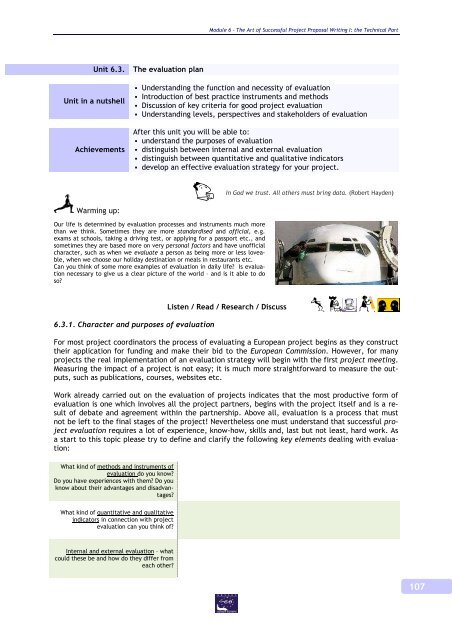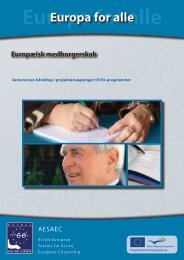We All are Europe - AESAEC
We All are Europe - AESAEC
We All are Europe - AESAEC
Create successful ePaper yourself
Turn your PDF publications into a flip-book with our unique Google optimized e-Paper software.
Module 6 – The Art of Successful Project Proposal Writing I: the Technical Part<br />
Unit 6.3.<br />
Unit in a nutshell<br />
Achievements<br />
The evaluation plan<br />
Understanding the function and necessity of evaluation<br />
Introduction of best practice instruments and methods<br />
Discussion of key criteria for good project evaluation<br />
Understanding levels, perspectives and stakeholders of evaluation<br />
After this unit you will be able to:<br />
understand the purposes of evaluation<br />
distinguish between internal and external evaluation<br />
distinguish between quantitative and qualitative indicators<br />
develop an effective evaluation strategy for your project.<br />
In God we trust. <strong>All</strong> others must bring data. (Robert Hayden)<br />
Warming up:<br />
Our life is determined by evaluation processes and instruments much more<br />
than we think. Sometimes they <strong>are</strong> more standardised and official, e.g.<br />
exams at schools, taking a driving test, or applying for a passport etc., and<br />
sometimes they <strong>are</strong> based more on very personal factors and have unofficial<br />
character, such as when we evaluate a person as being more or less loveable,<br />
when we choose our holiday destination or meals in restaurants etc.<br />
Can you think of some more examples of evaluation in daily life Is evaluation<br />
necessary to give us a clear picture of the world – and is it able to do<br />
so<br />
6.3.1. Character and purposes of evaluation<br />
Listen / Read / Research / Discuss<br />
For most project coordinators the process of evaluating a <strong>Europe</strong>an project begins as they construct<br />
their application for funding and make their bid to the <strong>Europe</strong>an Commission. However, for many<br />
projects the real implementation of an evaluation strategy will begin with the first project meeting.<br />
Measuring the impact of a project is not easy; it is much more straightforward to measure the outputs,<br />
such as publications, courses, websites etc.<br />
Work already carried out on the evaluation of projects indicates that the most productive form of<br />
evaluation is one which involves all the project partners, begins with the project itself and is a result<br />
of debate and agreement within the partnership. Above all, evaluation is a process that must<br />
not be left to the final stages of the project! Nevertheless one must understand that successful project<br />
evaluation requires a lot of experience, know-how, skills and, last but not least, hard work. As<br />
a start to this topic please try to define and clarify the following key elements dealing with evaluation:<br />
What kind of methods and instruments of<br />
evaluation do you know<br />
Do you have experiences with them Do you<br />
know about their advantages and disadvantages<br />
What kind of quantitative and qualitative<br />
indicators in connection with project<br />
evaluation can you think of<br />
Internal and external evaluation – what<br />
could these be and how do they differ from<br />
each other<br />
107









